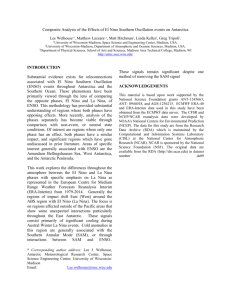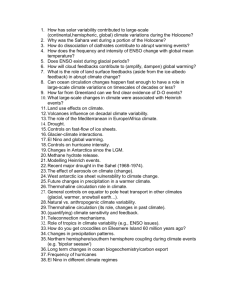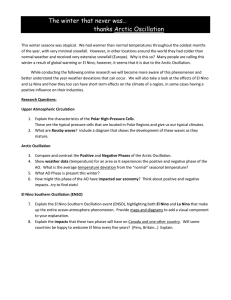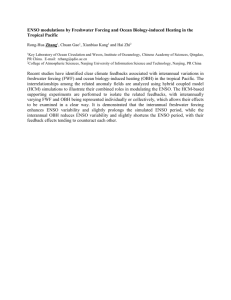THE EFFECT OF ENSO ON THE DYNAMICAL AND
advertisement
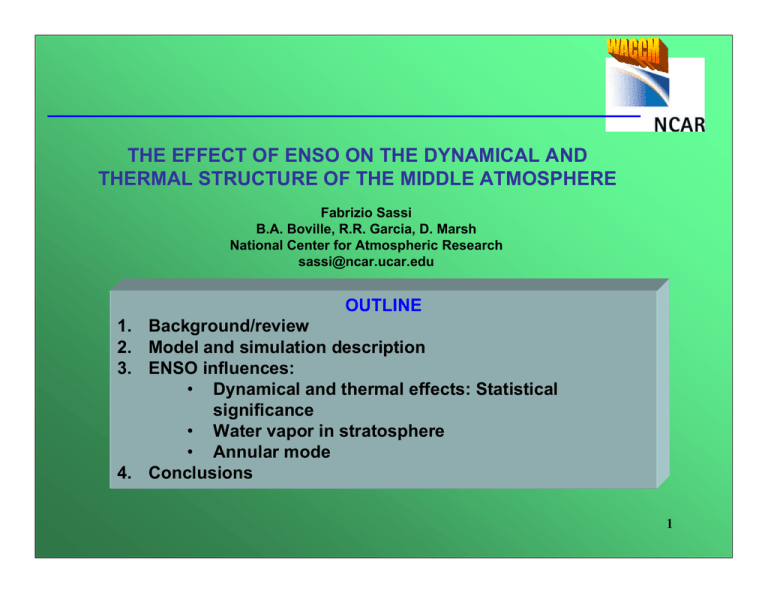
THE EFFECT OF ENSO ON THE DYNAMICAL AND THERMAL STRUCTURE OF THE MIDDLE ATMOSPHERE Fabrizio Sassi B.A. Boville, R.R. Garcia, D. Marsh National Center for Atmospheric Research sassi@ncar.ucar.edu OUTLINE 1. Background/review 2. Model and simulation description 3. ENSO influences: • Dynamical and thermal effects: Statistical significance • Water vapor in stratosphere • Annular mode 4. Conclusions 1 Background/Review Comp. Diff. Stat. Sign. • El Nino and Southern Oscillation (ENSO) impacts significantly tropospheric climate. 100 hPa • A PNA-like pattern emerges clearly. 250 hPa • Patterns of statistical significance highlight the PNA signature throughout the troposphere. 500 hPa Baldwin and O’Sullivan (1995) 2 Background/Review • Heat sources in the Tropics produce both tropically confined responses and laterally propagating wave-trains (PNA-like pattern). • In the numerical experiment shown on the lhs, transient heat source is located off the equator. • Barotropic Rossby-wave packets propagate laterally toward the extra-tropics. • The signature is typical of observed teleconnection patterns (e.g., Horel and Wallace, 1981). Garcia and Salby, 1987 3 Background/Review • The barotropic response emerges in stratosphere as planetary waves 1&2 which dominate the difference patterns between cold/warm phases. • Pattern of cold phases is uncorrelated to warm phases. • Anomalies of the cold phase are weaker than during warm phase. • Statistical significance is limited. Hamilton, 1995 4 Summary of Review and outstanding questions • Observations show a strong connection between ENSO and tropospheric climate. • Connection between ENSO and stratospheric structure is suggestive but not strong. • One problem is that in the real atmosphere ENSO variability is small compared to other sources of variability, principally those associated with the QBO. Other contributions include solar cycle, increase in greenhouse gases, and chemistry. •In a model with no QBO, nor solar cycle, nor increasing greenhouse gases, and with fixed chemical composition but with time dependent SST the only low frequency variability is associated with ENSO, aside from model’s internal variability. 5 Model and Simulation description WACCM: Whole Atmosphere Community Climate Model 6 Model/Simulation description TIME-GCM MLT Processes + WACCM MOZART-3 (version 1b) Offline Chemistry Dynamics + Physical processes CCM3 + extensions 7 Model/Simulation description • Based on NCAR Community Climate Model v.3 (CCM3) • T63 resolution (128 x 64 grid points) • 0-150 km (66 levels; ∆z =1.3 km in lower stratosphere to 3 km in thermosphere) • Semi-Lagrangian dynamics • 30 minute time step • Upper atmosphere extensions: • Lindzen GW parameterization • Short-wave (λ < 200 nm) heating rates from TIME-GCM • Parameterized ion-drag • non-LTE long-wave heating in the 15 µm band of CO2 • Interactive LW cooling (GHG), but SW heating from specified O3 8 Model/Simulation description Three 50-year simulations from 1950 throughout 2000 using observed sea surface temperature (SST) from NCEP Reynolds SST data set, http://podaac.jpl.nasa.gov/reynolds. Sea Surface Temperature Difference from long term average 9 Model/Simulation description Red = December Blue = January Green = February Black = March Sassi et al (2004) 10 Model/Simulation description • Three 50-year simulations contain 27 (=9x3) El Nino and 33 (=11x3) La Nina. • Composite differences of the extreme events are calculated • Statistical significance is determined from a Monte Carlo analysis and EOF. • Results are shown for temperature only. 11 ENSO Influences: Thermodynamic effects 12 Thermodynamic Effects El Nino – La Nina • High latitude zonal mean anomalies are significant (shading) at least at 95% level based on a t-test of a Monte Carlo analysis. •Smallest significance levels are in mid-winter. • Note the quadrupoles of positive/negative pairs in stratosphere/mesosphere. •Largest anomalies (and regions of significance) are obtained in late winter. • Note the positive (and always significant) anomaly in troposphere. Sassi et al (2004) 13 Thermodynamic Effects • The tropospheric signature of the PNA pattern stands out and is largely statistically significant. • The zonal structure shows wave 1&2 anomalies that are significant at all levels in stratosphere. • Westward rotation of the anomalies indicates that they are associated with Rossy-wave propagation. • 50hPa anomalies (and pattern of statistical significance) are similar to Hamilton (1995). Sassi et al (2004) 14 ENSO Influences: Statistical Significance 15 Statistical Significance Temperature EOF1 Correlation between NINO3 and PC1 = 0.17 Less than 2% of the total variance of temperature is explained by contemporaneous variations 16 of the NINO3 index. Statistical Significance Red = El Nino Black = Neutral Blue = La Nina • Overall, little correlation is found. • When only the extreme events are selected, some correlation emerges. • The population averages show that El Nino events are distinguishable from both La Nina and Neutral events. La Nina events, however, are not distinguishable from the Neutral ones. • The emerging correlation is solely due to positive excursions of the NINO3 index. 17 ENSO effects: WACCM water vapor 18 WACCM water vapor 19 tape recorder + low-frequency variability (+ trend?) WACCM water vapor • In WACCM, low-frequency variability in lower stratosphere is linked to ENSO 20 WACCM water vapor 21 ENSO effects: Annular modes 22 Annular Mode Baldwin and Dunkerton, Science, 2001 Model Weak vortex Strong vortex Note similarity to observations (and reversed color contours!) 23 The salient features of the observations can be reproduced by the model. Annular Mode Weak vortex composite 500 mb Strong vortex composite 500 mb Note PNA-like pattern: Several large-amplitude weak events occur in ENSO years 24 Annular Mode 45-d ave. following event onset 45-d ave. preceding event onset U is decelerated and shifted equatorward, consistent with a large T anomaly extending into the upper troposphere Fz (100 mb) blue: Fz for 11 strong events red: Fz for 19 weak events black: Fz for 50 random events ± 1 sd LATITUDE Fz (100 mb) averaged over 45 days preceding the events is much larger for weak events 25 Summary and Conclusions • During El Nino events the winter stratosphere is warmer, the mesosphere is colder. This is accompanied by anomalies of the mean meridional circulation that support those thermal anomalies. • Largest zonal mean temperature anomalies (and their statistical significance) are attained in late winter. Smallest anomalies in mid-winter. • A statistically significant zonal mean warming of the tropical troposphere is obtained during El Nino events and is present in all months. • The horizontal structure of the anomalies shows statistically significant planetary wave features throughout the stratosphere. • Variations of NINO3 explain less than 2% of the contemporaneous total variability of temperature. • Only positive excursion of NINO3 (Î El Nino) contribute significantly to variability in the middle atmosphere. Negative excursions (Î La Nina) are equivalent to no-events. 26 Summary and Conclusions • El Nino events are highly correlated with larger values of water vapor in mid-troposphere. • The same signal – although mitigated – propagates in stratosphere with a time delay associated with tropical mean upwelling. • The annular mode in WACCM is very similar to observations: downward progression and tropospheric influences are detected. • Weak stratospheric vortex events are associated with a strengthening of the tropospheric PNA pattern Î El Nino events. 27
